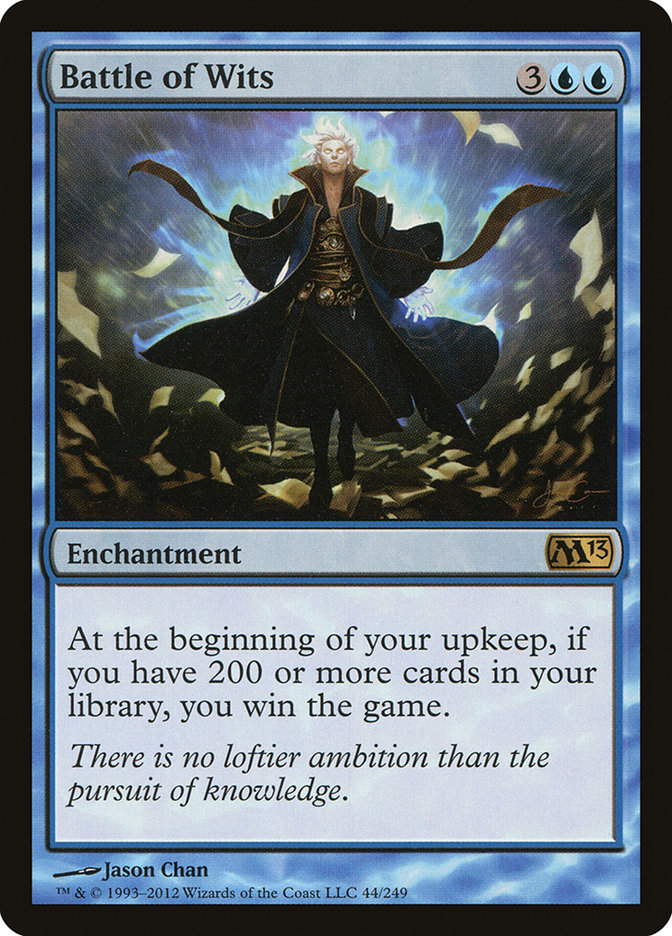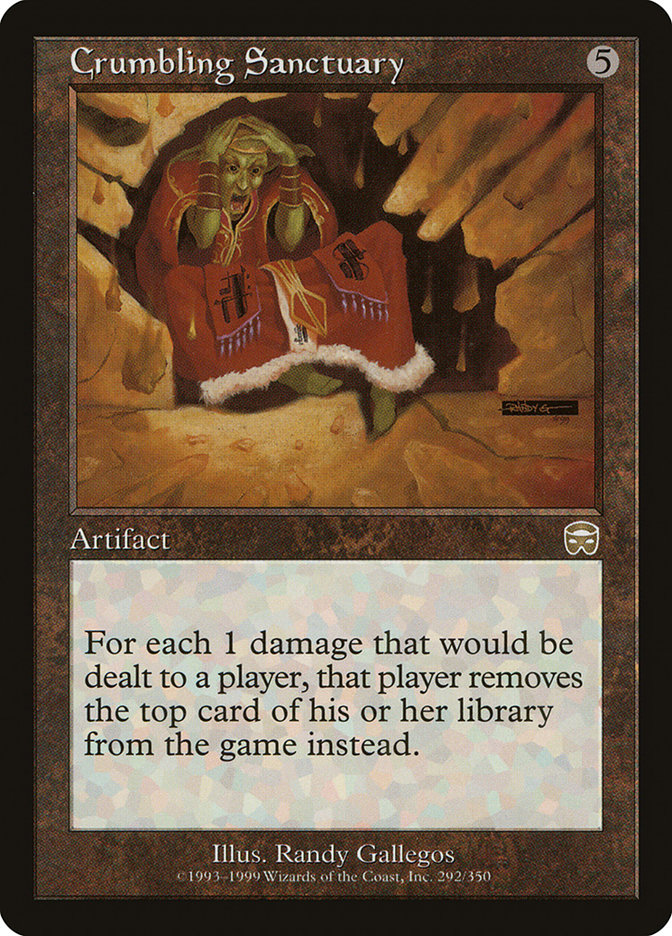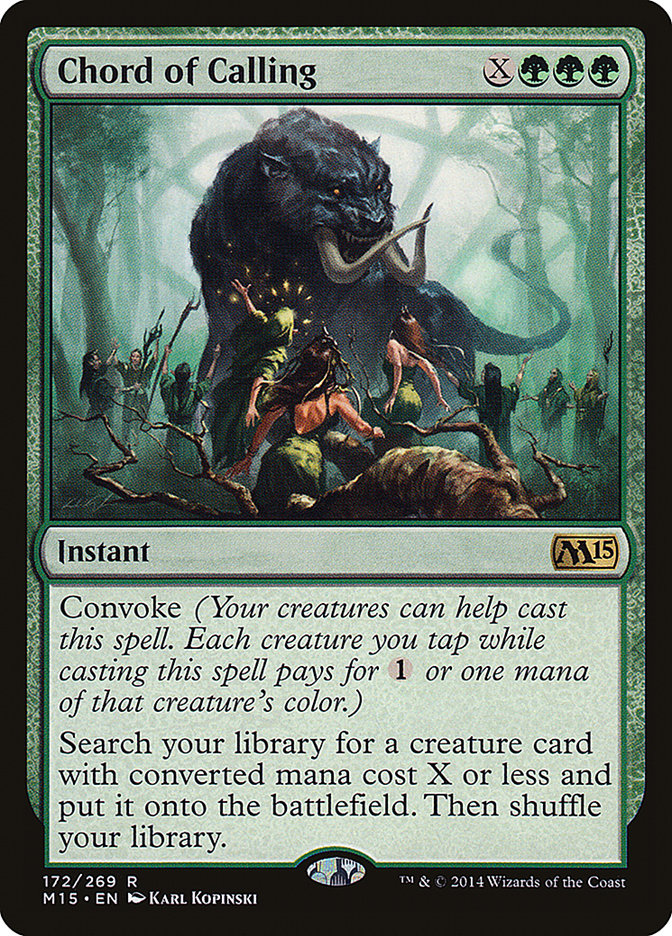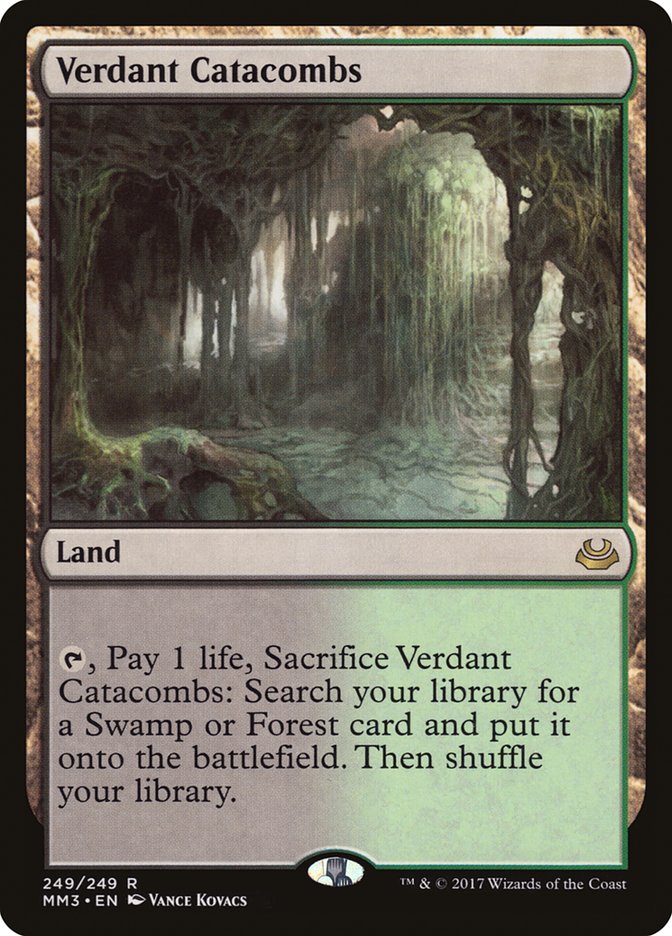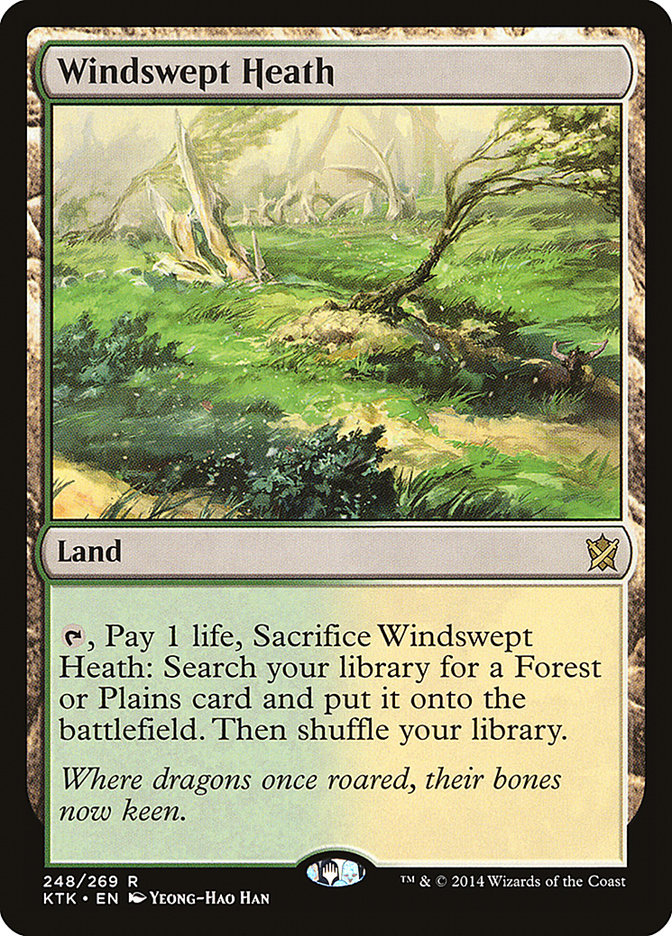I’ve been fascinated for a long time with the idea that, at some point, it will not be right to play exactly 60 cards in Constructed, and when that time comes, no one will have any idea how to build a deck.
The question current deckbuilding looks to answer is, “Which are the best 60 cards?” Whenever something is added, something has to be removed. This simplifies the process of deckbuilding in a way that I think is really important to making it manageable. Once you remove that restriction, how do you figure out how many cards you should play instead? When you add something, are you supposed to remove something? The task becomes much harder.
The typical reply to this is that it doesn’t matter because 60 will always be right, or at least it’ll be right often enough that considering alternatives isn’t worth the time. The most obvious and frequently used argument for playing the minimum number of cards is simple: some cards are better than others, some cards will be your best cards, and you don’t want to reduce the frequency with which you draw those cards. This argument is genuinely sufficient by itself most of the time, but there are other arguments that are even harder to imagine exceptions to; this argument depends in some ways on the card file available, but the others are closer to mathematical facts.
The biggest is sideboarding. You can’t increase the size of your sideboard with the size of your deck, so as you add more cards to your deck, you reduce the impact your sideboard cards can have; you get to change a smaller percentage of the cards in your deck and the most important cards you sideboard in will show up less. This is pretty similar to the first argument, that you’ll draw your best cards less often, but it highlights that it’s even more likely that you have some cards that are wildly better than your other cards in post-sideboard games.
Another big mathematical hurdle is that there’s actually a difference in the consistency of your draws between a 60-card deck with 24 lands and a 600-card deck with 240 lands. With a 60-card deck, if you’ve only seen two lands in your top ten cards, there are 22 lands out of 50 cards remaining, so rather than having a 40% chance to draw a land, you have a 44% chance, but with the 600-card deck, you have a 40.3% chance.
Basically, your draws are forced to balance out over time as you get through your deck because the ratios remaining in your deck change throughout the game, but that effect is minimized with a larger deck. In this case, that’s an extra land drop we’ll miss almost 3.7% of the time. Fortunately, that difference is much smaller when we’re talking about moving from 60 to 70 cards than when we’re talking about moving from 60 to 600 cards.
So, given those arguments against, what are the arguments for that could ever get us there? The most obvious, but also worst argument: in Magic, you lose when you run out of cards. The more cards you have, the less likely you are to run out.
This almost never matters when neither player’s gameplan is to attack the other’s library, and when that’s happening, the difference in size small numbers is only a difference of a turn or two. Yes, a full-on Battle of Wits deck will have a great matchup against a Sanity Grinding deck, but we’d need decks like that to be far more popular than they are for this to be a serious consideration.
Another common argument is the toolbox argument. If your deck is full of cards like Fauna Shaman and Chord of Calling so you have a lot of access to single copies of utility creatures in your deck, there’s a lot of extra value to each extra bullet you can fit, and on top of that, the more narrow bullets you put in, the less you want the odds of accidentally drawing one of them to be, so the more cards you have, the less likely your are to draw a narrow bullet that you’re hoping to only see when you search for it.
The problem with this is that you generally can’t afford to put more than a few bullets in your deck to begin with. If you have ten bullets in your deck, even if you’re playing 70 cards and viewing them all as “bonus slots” that “don’t take away from your other cards,” you’re still one-seventh bullets, meaning an opening hand will have an average of one bullet, which is like taking a mulligan every game if you assume bullets are narrow and not worth a card in the wrong place. The result is that these decks tend to choose one to three good, versatile bullets and relegate the others to the sideboard, and those one to three cards don’t really justify playing more than 60 cards.
The argument that I think is most relevant to Modern, the format where I think it’s most likely that playing more than 60 will be right first, is a variation on this argument that focuses on fetchlands specifically.
A strong case can be made that fetchlands are the most powerful cards in Modern, especially if we set aside a few possible exceptions like Mox Opal or maybe Lightning Bolt. To begin with, they’re lands that, with proper deck construction, function as any color of mana in our deck, like Evolving Wilds, except that they usually function as any two colors in our deck, and they don’t have to enter the battlefield tapped.
If you just paid some life and named two colors when you played a fetchland, and that land tapped for mana of those two colors for the rest of the game, they’d be better than all the other lands in Modern, but on top of that, they trigger landfall twice, count toward delirium, trigger revolt, allow you to shuffle your deck if you need to, and interact with a variety of other mechanics, as well as marginally “thinning your deck.”
Fetchlands are fantastic, and we’re allowed to play up to 40 of them, but even though people play twenty to 24 lands, they rarely play more than twelve fetchlands. The reason is that you need to have room in your deck to have lands to fetch. Consider Death’s Shadow, a deck that prefers to draw a fetchland over another land far more than the average deck. Even in these decks, people tend to play twelve fetchlands and six fetchable lands. This means only two-thirds of their lands are fetchlands.
If you increase the size of your deck, you need to play more lands, but you don’t really need to play more fetchable lands, so every additional land you add to your deck can be another fetchland. At some point, the fetchlands we have to add are a little worse than the ones first ones we were playing, (Marsh Flats isn’t as good as Bloodstained Mire in Grixis Death’s Shadow) and we might even need to add one more fetchable land to make sure that our lands do what we want.
But assuming that we don’t need to do that in Death’s Shadow, if we move from 60 cards to 70 cards while trying to keep our ratio of lands as similar as possible, we want to add three more lands, and all of them can be additional fetchlands, so now, instead of twelve of our eighteen lands being fetchlands, fifteen of our 21 lands are, so now we’ll draw fetchlands instead of other lands almost 5% more often.
There’s a good chance that’s not worth doing in Death’s Shadow specifically, because we also draw Death’s Shadow itself less often if we make the deck bigger, and Death’s Shadow is much better than the other spells we’d be adding. But not every deck is built around a single card that it was to draw as many of as possible like Death’s Shadow.
The bigger issue at play, I think, is the number of colors you can put in your deck. Basically, the conventional wisdom in Modern is that you can play up to three colors relatively smoothly with a fetchland-powered manabase. If you try to go to four colors, you need more different fetchable lands, which means you get fewer fetchlands, so more of your lands only offer access to one or two colors instead of three or four colors, and you can’t make the numbers work. If you’re willing to increase the size of your deck to include all the fetchable lands you want while flooding your ratios with fetchlands, the mana can actually work a lot better than it would in a four-color 60-card deck.
Imagine a balanced four-color deck that wants access to every relevant shockland. That makes six shocklands. Now, let’s imagine we want all four basics to minimize the amount of life we’ll have to lose each game, so we’ll call that ten fetchable lands we want. Let’s assume that we have a relatively low curve, but not Death’s Shadow low, so we’d want 22 lands in a 60-card deck. We’d have room for twelve fetchlands. In a 60 card deck, we’d have three shocklands of each color and a basic, so we have sixteen “sources” of each color, which is to saw that there are sixteen different cards that could be in our opening hand that would allow us to have green mana, for example.
If we played 80 cards instead, we’d still have the same ten fetchable lands, but now we could play nineteen fetchlands (while actually playing a very slightly lower percentage of total lands in our deck). Now, we have 23 sources of each color, which is like having 17.25 sources in a 60-card deck, so we’ve added a source of each color to our deck while reducing the ratio of lands just by increasing the size of our deck. This change isn’t huge, but it could easily be the difference between a manabase that plays out smoothly andconsistently and one that doesn’t, and remember that, on top of making our colored mana work better, we’re also just drawing fetchlands more often, meaning we get to take more advantage of all the fringe benefits of fetchlands.
Instead of adding a color and playing ten fetchable lands, we could stick to three colors and play six fetchable lands, and just use the increased fetchland ratios to turbo-charge a landfall/revolt/delve deck.
So what might all this look like in practice? Well, let’s start with the most obvious, Death’s Shadow–I know, I said we might not want to do this because we’ll draw Death’s Shadow less often, but Death’s Shadow is a deck that would really like both more fetchlands and more colors, so what happens if we push it pretty far? If we basically just mash all the different builds of Death’s Shadow together without cutting anything, I can imagine that it might be the best build. (Or it might be the worst. It’s really hard to know with something this outside-the-box.)
Creatures (23)
Planeswalkers (5)
Lands (29)
Spells (40)

29 lands, 21 fetchlands. Over 72% of lands are fetchlands. 25 sources of black and blue, 24 sources of red and green. That’s like 14.8 red sources in a 60-card deck, compared to fourteen in 60-card Grixis Death’s Shadow. This is to say that, despite the cost that each draw minimally impacts the composition of the rest of the deck, this deck probably has better mana than a 60-card deck with one less color (I’m not sure how problematic needing to fetch four colors instead of three will actually be to how games play out).
Obviously, for this starting point, I just included everything. I imagine that, with testing, I’d find that there were some cards I didn’t like as much, and I’d trim them, and gradually reduce the size of the deck in the process. If each change takes the form of either cutting or adding a card instead of replacing a card, and you simply play a lot and cut or add cards as they seem necessary, you could potentially naturally evolve toward an “optimal” deck size of some number greater than 60.
The biggest problem with this, and it’s a problem I genuinely don’t have a solution to, is sideboarding. The loss of efficiency of sideboarding is likely too high to allow you to play a deck this big, but I’m not sure if it’s too high to allow for somewhere in the middle. There are tradeoffs, and where there are tradeoffs, it’s hard to know that sticking on one extreme, the way players collectively, have, is right.
This is a simple first step in building like this, and it’s not the first time we’ve seen it. Scapeshift in particular has been pushed to more than 60 cards sometimes just to make the mana work when needing to fit too many Mountains into its manabase. The other application I’ve been mulling over is in building around revolt. Basically, I think Hidden Stockpile is a Modern-power-level card if your deck is good enough at triggering revolt, and pushing the number of fetchlands is a good way to do that. The problem is that I’m really not sure what the deck around it should look like at this point.
Regardless, I don’t know that now is the time for more than 60 cards, but I do know that as the card pool expands, it gets easier and easier to find more spells of a similar power level, but no other lands are close to the power level of fetchlands, so the incentives to build to maximize the power of our lands over the power of our spells do increase in some way over time, which is to say that, even if it’s not right now, it could be someday, and getting there first might be the best way to truly break Modern.


